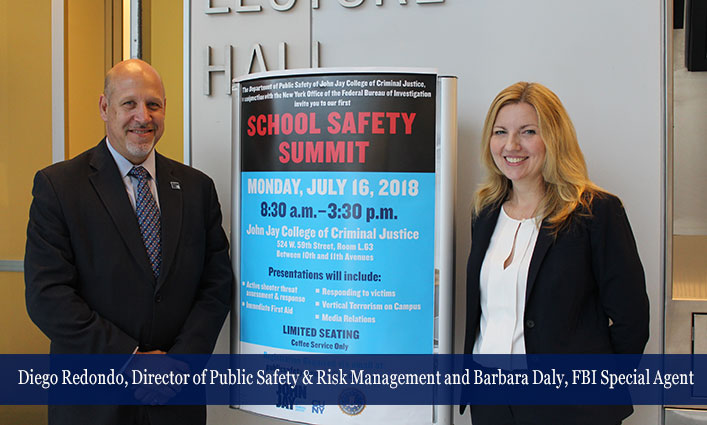
Columbine, Virginia Tech, Fort Hood Army Base, Aurora Movie Theater, Sandy Hook Elementary, Emanuel AME Church, Pulse Nightclub, Las Vegas Outdoor Concert, and Marjory Stoneman Douglas High School in Parkland Florida—the ever-growing list of active shooter situations in our country is staggering and sobering. The School Safety Summit held at John Jay on July 16th, co-sponsored by the John Jay College Department of Public Safety and the New York Office of the FBI, brought together some of the country’s leading experts on crisis situations, aiming to empower the John Jay community with information on: behavior indicators, threat assessment, tactical response, first aid, victim assistance, vertical terrorism, crisis management, and media relations.
“It’s not easy for us to imagine that our community might be in harm’s way, but with the mass shootings in schools, theaters, churches and workplaces, it’s responsible and essential for us to talk about these issues head on.” —President Karol V. Mason
“It’s not easy for us to imagine that our community might be in harm’s way, but with the mass shootings in schools, theaters, churches and workplaces, it’s responsible and essential for us to talk about these issues head on,” said President Karol V. Mason as she opened the event. “This School Safety Summit isn’t about fear, it’s about knowledge. Today’s speakers from the FBI and the New York City Fire Department are here to empower our community with information on how to avoid, handle and survive active shooter situations.”

Manage a Person of Concern
One of John Jay’s own, Special Agent Barbara Daly (’02), who has been involved with active shooter research and education since 2007, started the event off with an assessment presentation. “After the events of February 14th 2018 at Parkland, Florida, the FBI is inundated with requests to see these types of presentations,” said Agent Daly. She told the audience that it was the FBI’s responsibility to share threat assessment and behavioral indicator information with the public. “You can’t arrest someone just for thinking about doing something. We have to figure out creative ways to interrupt the ‘pathway to violence.’”
“We don’t have a crystal ball. I cannot tell you who’s going to become violent in any scenario. But based on red flag behaviors and warning signs, maybe we can prevent some of these things from happening.” —Barbara Daly, FBI Special Agent
Agent Daly cited the “pathway to violence” in six progressive steps developed by Fein and Fosskuil from the United States Secret Service: 1. Grievance, 2. Ideation, 3. Research & Planning, 4. Preparation, 5. Breach, 6. Attack. “We see that these folks are thinking about a possible attack for years in advance sometimes. So that gives us a lot of opportunities to spot these red-flag behaviors, and report them to the appropriate folks,” she said. In most of the crisis situation cases (81%) people around the active shooter noticed these behaviors, but didn’t report them. “Maybe they didn’t know who to tell. Maybe they didn’t want to seem like a snitch. Maybe they didn’t take it seriously,” Agent Daly said, but she noted that their information can be critically important in preventing a crisis situation.

Seeing the Signs
Agent Daly showed the audience many statistics on active shooters—for example 94% of the offenders were male—but cautioned against profile thinking. Instead, she shared certain common signs that occurred before most crisis situations. Looking at many active shooters, Daly presented these indicators: prone to outbursts of anger, behavioral issues, mental health history, and a grievance or loss—which can be a triggering behavior.
Agent Daly went on to describe what the FBI call “brittle people.” These are individuals that are: unable to withstand slights or rejections, have feelings of persecution or alienation (real or perceived), and are outsiders. Many active shooters express these feelings long before they commit any acts of violence. “We don’t have a crystal ball. I cannot tell you who’s going to become violent in any scenario. But based on red flag behaviors and warning signs, maybe we can prevent some of these things from happening.”
For more information about Active Shooter Preparedness, click here.
For more information about FBI Behavioral Analysis, click here.



